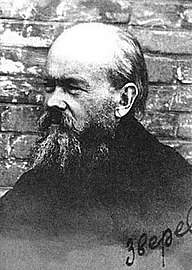Top Qs
Timeline
Chat
Perspective
November 1 (Eastern Orthodox liturgics)
From Wikipedia, the free encyclopedia
Remove ads
Oct. 31 - Eastern Orthodox liturgical calendar - Nov. 2

All fixed commemorations below celebrated on November 14 by Orthodox Churches on the Old Calendar.[note 1]
For November 1st, Orthodox Churches on the Old Calendar commemorate the Saints listed on October 19.
Saints
- Holy Wonderworkers and Unmercenaries Cosmas and Damian of Mesopotamia and their mother Venerable Theodota of Mesopotamia (c. 287)[1][2][3][note 2]
- Martyrs Cyrenia and Juliana in Cilicia (305)[1][4][5]
- Hieromartyr John the Bishop and James the Presbyter of Persia (345)[1][6][7]
- Martyrs Caesarius, Dacius, Sabbas, Sabinian, Agrippa, Adrian, and Thomas at Damascus (7th century)[1][8][note 3]
- Saint Theolepte, martyr.[9][note 4]
- Martyrs Cyprian and Juliana[10][note 5]
Remove ads
Pre-Schism Western saints
- Martyr Mary the Slave Girl (c. 117-138)[11][note 6]
- Saint Austromoine (Austremonius, Stremoine), first Bishop of Clermont-Ferrand and "Apostle of Auvergne" (c. 250)[1][7][11]
- Saint Benignus of Dijon, Priest and Apostle, of Burgundy (c. 272)[1][11][note 7]
- Martyrs Caesarius, a Deacon of Africa, together with Julian, a local presbyter, martyred at Terracina in Italy (c. 284-305)[11][note 8]
- Saint Maturinus (Mathurin), confessor, French exorcist and missionary, apostle and patron of Gâtinais (c. 300)[7][11]
- Saint Marcellus, 9th Bishop of Paris (c. 430)[1][7][11]
- Saint Amabilis of Riom (475)[11]
- Saint Cledwyn (Clydwyn), patron saint of Llangedwyn in Clwyd in Wales (5th century)[11]
- Saint Pabiali of Wales, patron-saint of Partypallai in Wales (5th/6th century)[11][note 9]
- Saint Dingad of Llandingat (5th century)[11]
- Saint Magnus of Milan (530)[12]
- Saint Vigor, disciple of St Vedast, became Bishop of Bayeux, resolutely opposed paganism (c. 537)[7][11]
- Martyr Hermeningild the Goth, Prince of Spain (586)[1][13][14]
- Saint Gwythian (Gothian, Gocianus) of Cornwall (6th century)[15]
- Saint Cadfan, Abbot of Tywyn and Bardsey (6th century)[11]
- Saint Caillin, a disciple of St Aidan of Ferns in Ireland (6th century)[11]
- Saint Ceitho, one of five brothers, all saints in Wales (6th century)[11]
- Saint Licinius of Angers (Lesin, Lezin), chosen Bishop of Angers in 586 and consecrated by St Gregory of Tours (c. 616)[11] (see also: February 13)
- Saint Caesarius, Bishop of Clermont in France (c. 627)[11]
- Saint Floribert (Florbert), Abbot of monasteries in Ghent, Mont-Blandin and Saint-Bavon in Belgium (c. 660)[11]
- Saint Genesius of Lyon (c. 679)[11]
- Saint Severinus, a monk who lived as a hermit in Tivoli in Italy (c. 699)[7][11][note 10]
- Saint Germanus of Montfort, born in Montfort in France, became a monk at the monastery of Savigny, reposed as a hermit (c. 906-1000)[11]
Remove ads
Post-Schism Orthodox saints
- Venerable James of Mount Athos and his two disciples James the Deacon and Dionysius the Monk (1520)[16][17]
- Venerable Saint David of Euboea (1589)[18]
- New Virgin-Martyr Helen of Sinope (18th century)[1][19]
New martyrs and confessors
- Hieromartyrs Alexander (Smirnov), and Theodore (Remezov), Priests (1918)[20][21][22]
- New Hieromartyr Sergius (Zverev), Archbishop of Elets and Melitopol (1937)[1][20][note 11]
- New Hieromartyr Alexander Shalay, Priest (1937)[20][22]
- New Hieromartyr Demetrius (Ovechkin), Priest of Perm (1937)[20][21][22]
- Virgin-martyr Elizabeth Samovskoy (1937)[20][22]
- Martyr Peter Ignatov (1941)[20][22]
Other commemorations
Icon gallery
- Martyrdom of St. Austremonius (stained glass window from the church Saint-Austremonius of Issoire, Auvergne, France).
- Stained glass window of Saint-Mathurin converting idolaters, including his father and mother.
- Venerable Saint David of Euboea.
- Hieromartyr Sergius (Zverev), Archbishop of Elets and Melitopol.
Notes
- The notation Old Style or (OS) is sometimes used to indicate a date in the Julian Calendar (which is used by churches on the "Old Calendar").
The notation New Style or (NS), indicates a date in the Revised Julian calendar (which is used by churches on the "New Calendar"). - The Unmercenary Saints Cosmas and Damian of Asia Minor should not be confused with the Unmercenary Saints Cosmas and Damian of Rome (July 1), or the Unmercenary Saints Cosmas and Damian of Arabia (October 17).[3]
- Mentioned in Parisian Codex 259, sheet 2a.
- "At Dijon, St. Benignus, a priest, who was sent to France by blessed Polycarp to preach the Gospel. After he had been subjected to many most grievous torments, by the judge Terentius, under the emperor Marcus Aurelius, he was finally condemned to have his neck struck with an iron bar and his body pierced with a lance."[7]
- See also: Peibio Clafrog.
- His relics are in the church of St Laurence in Tivoli.
- See also: (in Russian) Сергий (Зверев). Википедии. (Russian Wikipedia).
- "A close disciple of Elder Naz-arius and his beloved cell-attendant during Naz-arius' stay as a recluse in the wilderness of Valaam, Fr. Hilarion accompanied him also to Sarov Monastery, where he was to defend St. Seraphim's orphans to such an extent that he was even banished for several years from Sarov. St. Seraphim had all the nuns of his Diveyevo Convent tonsured only by Fr. Hilarion, who was also to lay the beginning of St. Seraphim's glorification, finding his own final resting place near those of St. Seraphim and his beloved Abbot Nazarius. Elder Hilarion was a writer and left a brief "Ladder of Divine Ascent" which was published together with the Counsels of Abbot Nazarius. Since the latter did not know how to write, Fr. Hilarion took down Nazarius' teachings. The engraving on the left is taken from the Sarov Patericon which, although regrettably brief, nevertheless shows clearly that the Paisian influence upon Russia did not fall on barren ground. There were deep spiritual currents that consciously preserved me national holiness of St. Tikhon of Zadonsk and the Elders of the Roslavl and Sarov forests and welcomed the Athonite spirit which came from Moldavia."[23]
Remove ads
References
Sources
Wikiwand - on
Seamless Wikipedia browsing. On steroids.
Remove ads





